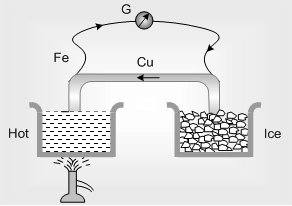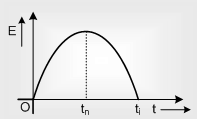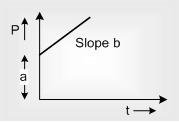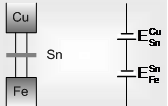Definition: When the two junctions of a thermo couple are maintained at different temperatures, then a light starts going through the loop known as thermo electric current. The potential energy difference in between the junctions is called thermo electric emf which is of the order of a few micro-volts per degree temperature difference (mV/°C).

See beck Series: The value and direction of thermo emf in a thermocouple depends not only on the temperature difference between the hot and cold junctions but also on the nature of metals constituting the thermo couple.
(i) Seebeck arranged different metals in the decreasing order of their electron volume. Few metals creating the series are as below.
Sb, Fe, Zn, Ag, Pb, Hg, Au, Cr, Sn, Cd, Mn, Cu, Pt, Co, Ni, Bi
(ii) Thermo electric emf is directly proportional to the distance between the two substances in series. Farther the substances in the series forming the thermo couple greater are the thermo emf. Thus maximum thermo emf is obtained for Sb-Bi thermo couple
(iii) The current flow at the hot junction of the thermocouple is from the metal happening later in the series towards that happening earlier, so, in the copper-iron thermocouple the current flows from copper (Cu) to iron (Fe) at the hot nods. That can be remind easily by the hot coffee.
Variation of thermo emf with temperature: In a thermocouple as the temperature of the hot junction increases keeping the cold junction at constant temperature (say 0°C). The thermo emf increases till it becomes maximized at a certain temperature.

(i) Thermo electric emf is given by the equation E= αt + 1/2βt2 where α and β are thermo electric constant having units are volt/°C and volt/°C2 respectively (t = temperature of hot junction). For E to be maximum (at t = tn)
dE/dt=0
(ii) The temperature of hot junction at which thermo emf becomes maximum is called neutral temperature (tn). Neutral temperature is constant for a thermo couple (e.g. for Cu-Fe, tn = 270°C)
(iii) Simple temperature is not dependent of the temperature of cold junction.
(iv) If temperature of hot junction increases beyond neutral temperature, thermo emf start losing and at a particular temperature it converts into zero, on heating slightly further, the direction of emf is saved. That temperature hot junction is known as temperature of inversion (ti).
(v) Relation between tn, ti and tc is tn = ti+tj/2
Thermo electric power: The rate of modification of thermo emf with the change in the temperature of the hot junction is called thermoelectric power.
It is also provided by the slope of parabolic curve representing the variation of thermo emf with temperature of the hot junction, as discussed in previous section.
The thermo electric power is also called Seebeck coefficient. Differentiating both equations of thermo emf with respect to t, we got thermoelectric power
|
P = dE/dt = d(αt + 1/2βt2)/dt
=> p =α + βt
The equation of the thermo electric power is of the type
y = mx + c, so the graph of thermo electric power is as shown.
|

|
Laws of thermoelectricity
(i) Law of successive temperature : If initially temperature limits of the cold and the hot junction are t1 and t2, say the thermo emf is Ei. When the temperature limits are t2 and t3, then say the thermo emf is Ei =E1+E2 then Ei where is the thermo emf when the temperature limits are E01
(ii) Law of intermediate metals : Let A, B and C be the three metals of Seebeck series, where B lies between A and C. According to this law, Ei =E1+E2
|
When tin is used as a soldering metal in Fe-Cu thermocouple then at the junction, two different thermo couples are being formed. One is between iron and tin and the other is between copper and tin, as given in diagram.
If the soldering metal does not lie between two metals (in Seebeck series) of thermocouple then the resultant emf will be subtractive.
|

|
Email based Physics assignment help - homework help at Expertsmind
Are you searching physics expert for help with Seebeck Effect questions? Seebeck Effect topic is not easier to learn without external help? We at www.expertsmind.com offer finest service of Physics assignment help and physics homework help. Live tutors are available for 24x7 hours helping students in their Seebeck Effect related problems. We provide step by step Seebeck Effect question's answers with 100% plagiarism free content. We prepare quality content and notes for Seebeck Effect topic under physics theory and study material. These are avail for subscribed users and they can get advantages anytime.
Why Expertsmind for assignment help
- Higher degree holder and experienced experts network
- Punctuality and responsibility of work
- Quality solution with 100% plagiarism free answers
- Time on Delivery
- Privacy of information and details
- Excellence in solving physics queries in excels and word format.
- Best tutoring assistance 24x7 hours